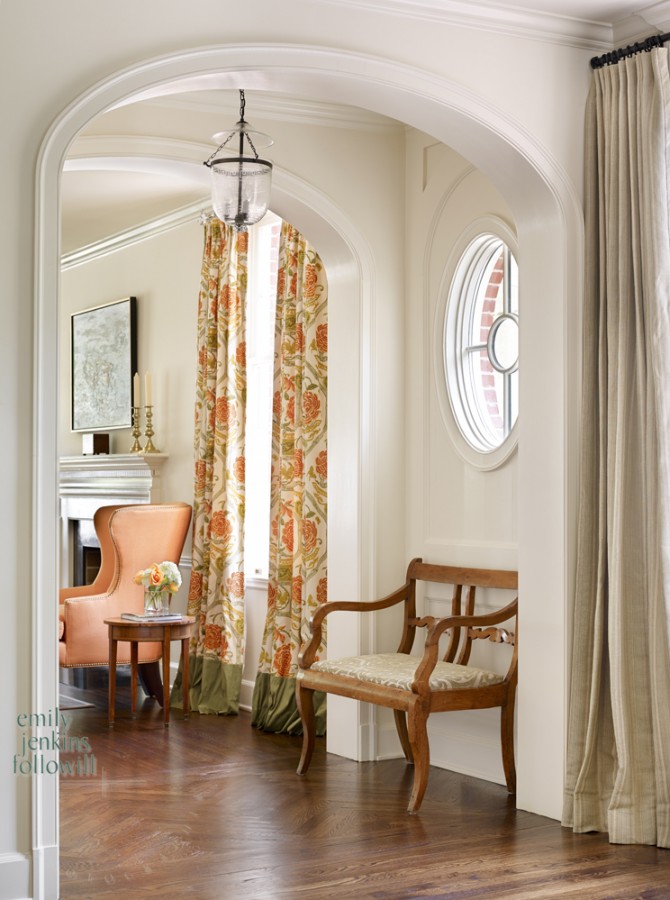A Case for Compromise
I don’t know who was building houses in St. Charles in 1989. Judging from the similar floor plans, it seems possible that a lone builder tore across the east side, armed with a single plan and a tool belt. He must have had a boat-load of taupe trim paint too.
St. Charles is due west of Chicago. All kidding aside, it is actually quite lovely, steeped as it is in turn-of-the-century history. The Fox River runs through St. Charles, north to south, providing a natural boundary and effectively splitting our town in half. On the east side, closest to the City, homes tend to be a bit older, as if Chicago expanded right up to the Fox River and couldn’t gain passage for a couple decades. Houses are either small, turn-of-the-century bungalows, or quite large, a product of late-century fondness for oversizing.
The early-century homes are popular among the rehabbers here, while late-century homes, with their generous proportions and European influences, haven't been touched in ages. Formal rooms were still very much in vogue in the late 1980’s, when my home was built. Many of them sit, to this day, decorated to the nines and largely unused.
You’ve noticed, surely, the trend towards the informal. People don’t like to dress up anymore, for example. Yoga-wear is a legitimate fashion genre. Slippers are acceptable footwear in some circles. Comfort is King.
Homes, too, have become more casual. Farmhouses are all the rage. Modern families eschew formal rooms and fine china, dismissing them as fussy and impractical. Rehabbers are enthusiastically knocking down walls in the turn-of-the-century bungalows downtown. Open-concept has replaced traditional floor plans, essentially eliminating walls in the common areas, and, with them, formality.
You’re probably not shocked, with my fondness for European gardens, that I like some division in my living spaces. I have an affinity for boundaries, literal and figurative. Kitchens for cooking. Living rooms for living. That kind of thing. It seems rigid, maybe, but the upside is I rarely have to clean food off my sofa; no one eats on it. The lines are clearly drawn in our house, thanks to that prolific builder who, as recently as the 1980's, understood the value of separate rooms.
Shane and I did have one completely open-concept home, and, astonishingly, we bought it twice. It turns out that we didn’t notice some things until the second go-round. Chiefly, we noticed problems with (A) noise and (B) art placement, but, if I had to add a third beef, it would be (C) challenging furniture placement. (Spoiler alert: upcoming post about furniture placement in open rooms.)
Here's a peek inside our open-concept home.
Open-concept is a relatively new term. Most homes built before 1950 were truly closed floor plans with lots of smaller, self-contained rooms. Bungalows - compact, affordable, and therefore popular in the early 20th century - featured a centralized living space surrounded by the essentials: kitchen, living, dining, bed, bath. Over time, lines blurred between these spaces to accommodate the changing needs of the family. Breakfast rooms were annexed into the kitchen, for example. Living rooms became entertainment hubs. However, formal rooms, if they existed at all, remained segregated (and plastic-covered) for decades. In the 2000's, they finally met their demise.
Comically, people are appalled by this very traditional concept now. We’d all like to be in the same room, please, while we visit electronically with others who are not actually in the room. The merit to traditional homes, in my view, is they have - wait for it - walls! Walls provide so many desirable things, including (but not limited to) privacy, noise reduction, insulation, and places to hang stuff. Walls also make furniture placement easier, or at the very least, obvious.
Conversely, the open-concept allows for breathing room, plus sweeping views and sight-lines. It enables all aspects of family life to take place in one room, which is, I gather, the entire appeal. I can’t argue with the convenience factor. If you’re a neat-freak, though, open-concept living might really wreck your mojo.
Lest I sound like an advocate to reconstruct all walls forthwith, let me concede that too many walls can really hem a person in. The prevailing modern solution to walls and their pesky site-line restrictions has been to get rid of them altogether, thereby effectively eliminating all the very fine things that walls provide in a home (see list above). Surely there is a happy medium.
Comfort, we established, is King. I submit that Beauty is an equally important, if slightly lesser royal, say, Queen. My personal mantra has always been “beauty before comfort,” though I am beginning to see the merits of both perspectives. As a child, I bore with gladness the discomfort of certain (adorable) shoes because I valued beauty over comfort. (I may or may not have slept in said shoes.) In truth, I’m not sure comfort has to be compromised for beauty, or vise versa. There, I said it. Most things can be comfortable and pretty. (As long as you don't sleep in them.)
Therefore, I have changed my opinion, over time, about what constitutes a perfect floor plan. A traditional feel with a semi-open vibe, breathable and connected, sans open-concept echo represents a merging of the minds, if you will. Open-ish, without the cons. A little separation, in my mind, goes a long way.
Semi-traditional? Semi-open? Call it what you will. It's cozier to me than wide-open spaces. I’m a nester. I like a home to embrace me. Add in the organization factor, and a place to hang pretties, and I'm sold. Oh, and another perk of walls? A plethora of gorgeous, eat-your-heart-out trim, paper, and paint options of which to avail yourself. It's not just about a place to hang your velvet Elvis.
I'm not advocating a return to parlors and petticoats. I'm not completely archaic. It's just that most things come down to balance, don't they? I vote for borrowing the best of everything to get the perfect thing. I'm making a case for compromise.
Below: Examples of semi-open homes, with walls that enhance, not hinder, views, site-lines, and togetherness. Notice the fabulous wall treatments, and the conceal/reveal architecture.
Curious? Here's more info on maximizing your open-concept home, and here you'll find a interesting article on bungalows. Here is the new traditional home, and here is some information on my fair town of St. Charles, Illinois.










